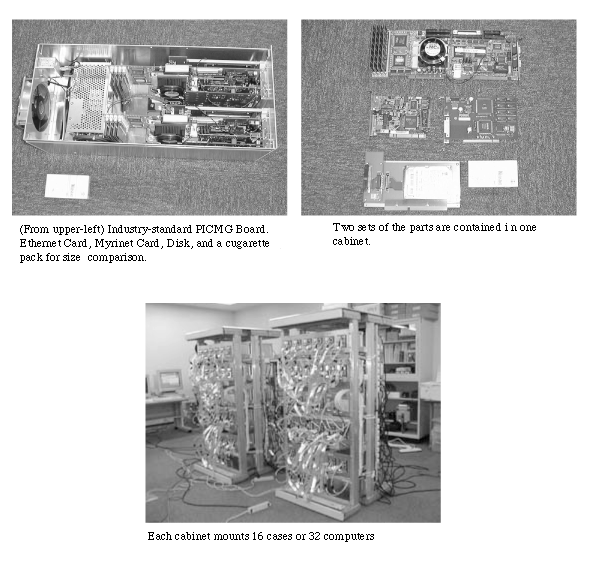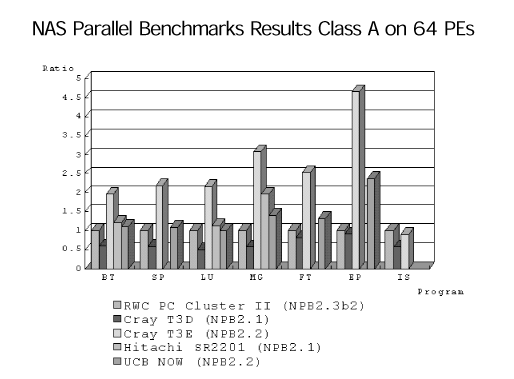 Basic Research on Low-cost
Parallel Computers
Basic Research on Low-cost
Parallel Computers
 Basic Research on Low-cost
Parallel Computers
Basic Research on Low-cost
Parallel Computers
The Real World Computing Partnership (RWCP) is conducting R&D of fundamental technologies required to address various computing demands in the Internet and multimedia society of the future. The growth of the PC market and advances in device technologies have improved the cost-performance of PCs and made low-price, high-speed computers readily available. By connecting standard PCs with a high-speed computer network, hardware performance (theoretical performance) may achieve processing power comparable to a supercomputer. Simply connecting off-the-shelf PCs, however, is not sufficient for creating a supercomputer-level system because of the lack of basic software to derive the computer power as well as of problems in maintainability and occupied area. Therefore, the Parallel Distributed System Software TRC Laboratory has been developing workstation/PC cluster systems since 1995 as shown in Fig. 1 to realize supercomputer-level computer systems consisting of multiple PCs (SuperPC Systems) by solving these problems.
1995
April: The development of cluster technology (studied
high-speed networks) is started.
August: Workstation Cluster I (with 5 nodes) on Sun
SPARCstation 20 is installed.
October: A communication software, PM, is prototyped.
November: A parallel programming language, MPC++, is
prototyped.
A single-user environment parallel operating
system, SCore-S, is prototyped.
1996
February: Workstation Cluster I is extended to 9 nodes.
March: Workstation Cluster II (with 36 nodes) is
installed.
April: The development of the prototype of PC Cluster
is started.
June: The transfer speed of 100 Mbytes/sec at the user
level with communications software PM is achieved.
September:Cray T3D-level performance is achieved on
Workstation Cluster (measured by a benchmark program);
PC Cluster I hardware is installed;
A multi-user environment parallel operating system,
SCore-D, is prototyped.
November:RWC PC Cluster I is demonstrated at SuperComputing'96
(Pittsburgh, USA).
1997
February: MPI is ported.
October: PC Cluster II is installed;
Demonstrated performance at the existing supercomputer
level with benchmark programs (see Attachments).
November: RWC PC Cluster II is demonstrated at SC'97 High
Performance Networking and Computing (San Jose, USA).
1998
Spring: Plan to extend RWC PC Cluster II to 128 nodes.
|  |
 Completed PC Cluster II: A
Super PC System Connecting 64 PCs
Completed PC Cluster II: A
Super PC System Connecting 64 PCs
In the autumn of 1996, we completed the RWC PC Cluster II, a Super PC System connecting 64 PCs. As shown in Fig. 2, PC Cluster II connects 64 computers (nodes) via Myricomıs Myrinet high-speed network, each consisting of a mother-board mounting an Intel Pentium Pro (200 MHz) CPU as used in PCs, 256-MB main memory and 2-GB hard disk.
In order to make the system compact and easy to maintain, a PICMG (PCI Industrial Computer Manufacturers Group) standards mother-board is used as a node computer (Fig. 3). The volume has been reduced to just 1/30 of the Workstation Cluster that we developed in 1995. Also, this model provides a multi-user environment while maintaining high-speed performance.

Fig.3:RWC PC Cluster II,Parts and Overview
 Benchmark Programs Showing
Benchmark Programs Showing
Leading-edge Supercomputer-level Performance
RWC PC Cluster II, the successor of RWC PC Cluster I developed in 1995, has the theoretical performance of 12.8 GFlops (12.8 trillion floating-point operations per sec). It has been verified with a set of benchmark programs, developed by NASA, that PC Cluster II has achieved leading-edge supercomputer-level performance (see Fig. 4). The IS (Integer Sort) program in this benchmark program showed that PC Cluster II has achieved higher performance than a leading-edge supercomputer with the same number of nodes. PC Cluster II has also achieved approximately 50% of the performance of a leading-edge supercomputer in numeric computing (simultaneous linear equation).
 This graph summarizes the results obtained by executing
NAS Parallel
Benchmarks developed by NASA. The data provided by NASA
over the WWW
was used for the performance of parallel computers other
than RWC PC Cluster II.
The vertical axis indicates the relative speeds of other
parallel computers with the
performance of RWC PC Cluster II. For example, ratio 2
means that it is twice as
fast as RWC PC cluster II.
BT and SP are benchmarks based on the algorithm used to
solve Computational
Fluid Dynamics. LU, MG, FT, and IS are programs used to
solve linear equations,
3-dimensional Poisson equations, Fourier transforms, and
integer sort, respectively.
EP is a program to measure the performance of
floating-point operations.
The performance of the EP program may be considered a
single processor
performance. Other systems achieved more than double the
performance over PC
cluster II as a single processor, but not so with
parallel programs. PC Cluster II
attained higher performance than the previous generation
of Cray T3D and also
with IS program than the latest Cray-T3E. |
 Key Technologies:
Newly-developed
Key Technologies:
Newly-developed
High-speed Network Driver, Parallel Operating System
Such high performance has been achieved by developing a communication facility called PM and a new parallel operating system called SCore-D. A multi-user environment has also been realized without sacrificing high-performance processing, unlike other systems of the same type.
PM has achieved approximately 100 times faster than other communication libraries, such as the conventional TCP/IP. We have also achieved a four-fold improvement in performance over the old PM implemented on the RWC PC Cluster I. Figure 5 shows the comparison between RWC PC Clusters I and II.
The parallel operating system, SCore-D, is implemented on top of UNIX kernel, and achieves an efficient schedule to run multiple parallel application programs without modifying UNIX kernel. Cooperating with the PM, it supports a multi-user environment without decreasing the high performance capability.
 Focus on Software
Portability
Focus on Software
Portability
MPI, a standard communications library in the parallel computing field, is available on the system. This facilitates porting of many software programs that run on supercomputers. The system uses UNIX, the industry standard in the workstation field, as the kernel operating system. This parallel computing environment, with low-price computers and a user-friendly milieu, brings supercomputers, which have been desired but difficult to handle in the past, within the reach of researchers and engineers.
 SuperPC System: Fundamental
Technology for Emerging Internet and Multimedia Society
SuperPC System: Fundamental
Technology for Emerging Internet and Multimedia Society
The developed technology will be a key technology for the emerging Internet and multimedia society. Currently, users are being forced to replace server computers that deliver information with expensive paralleled computers, as the number of accesses and the amount of information to be provided increases. By using the technology developed at RWCP, it is possible to meet the demand by starting with a single PC for providing information and then adding PCs and high-speed networks as required to increase processing ability. A new type of server computer environment, one that can be realized at lower cost and without disposing of legacy computer resources, will act as a driving force to extend the boundaries of the emerging Internet and multimedia market.
This new environment is a fundamental software technology that enables the provision of supercomputer-level systems by reclaiming unused PCs and linking PCs via a high-speed computer network in an office. It should provide a foundation to enable applications that require computing power (i.e., document processing systems which exploit multimedia technology) to spread into offices as well. We plan to enhance the basic developed software technology as well as develop faster and higher-function network hardware to make it possible to use SuperPC Systems in offices, laboratories, and research institutes.Available Software
Fig.5: Comparison Between RWC PC Cluster I and II
The basic software developed on RWC PC Cluster II, which is still in the R&D stage, is now available for promotion and user feedback. To use the software, the Associated License Agreement must be made with us. For details, see the following URL http://www.rwcp.or.jp/lab/pdslab/dist/.